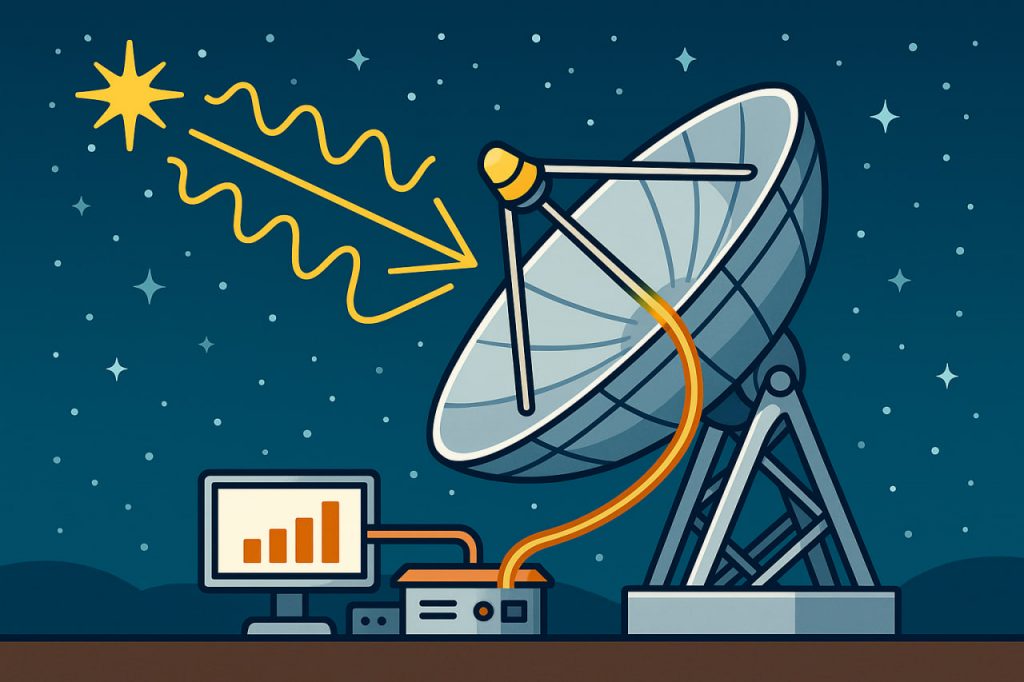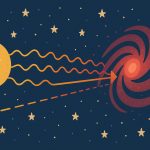Unlike traditional optical telescopes that capture visible light, a radio telescope detects radio waves emitted by celestial objects. These waves are part of the electromagnetic spectrum, but they have much longer wavelengths than visible light — sometimes stretching for meters. Because radio waves can travel through clouds, dust, and even the Earth’s atmosphere, radio telescopes open a unique window into the cosmos. They allow astronomers to study phenomena that are invisible to optical telescopes, such as pulsars, quasars, cosmic background radiation, and interstellar gas clouds.
The Basic Components of a Radio Telescope
A radio telescope generally consists of three main parts:
- Dish Antenna (Reflector): A large, curved surface — often parabolic — that collects radio waves and reflects them to a central point.
- Receiver (or Feed Horn): Located at the focal point of the dish, it captures the concentrated radio signals and converts them into electrical signals.
- Amplifier and Data System: These signals are then amplified, filtered, digitized, and processed by computers to extract meaningful information, such as intensity and frequency.
This setup allows astronomers to “listen” to the faintest signals coming from millions or even billions of light-years away.
How It Works: From Waves to Images
When a distant object like a galaxy or black hole emits radio waves, those waves travel across space and eventually reach Earth. The large surface of the dish collects these weak signals and reflects them to the receiver. Because radio waves are so faint, amplification is critical. Once amplified, the signals are digitized and processed into data that scientists can analyze or convert into visual maps or spectral graphs.
Some advanced radio telescopes, like interferometers, use multiple dishes spread out over large distances. By combining the data from these dishes, astronomers achieve much higher resolution — similar to having one massive telescope with the same width as the entire array.
Advantages of Radio Telescopes
Radio telescopes offer several key advantages:
- They work day and night, since radio waves aren’t affected by sunlight.
- They can see through clouds and dust, allowing observations in all weather and even of regions obscured in visible light.
- They detect unique cosmic phenomena, such as hydrogen emissions, rotating pulsars, and signals from distant galaxies.
Thanks to these capabilities, radio astronomy has led to major discoveries, including the cosmic microwave background and the first detection of exoplanets via radio emissions.
Famous Radio Telescopes Around the World
Some of the most well-known radio telescopes include:
- FAST (China): The world’s largest single-dish radio telescope.
- Very Large Array (VLA) (USA): A network of 27 dishes used for high-resolution interferometry.
- ALMA (Chile): Located in the Atacama Desert, it observes at millimeter and submillimeter wavelengths.
- LOFAR (Europe): A next-generation telescope that uses thousands of small antennas instead of a single dish.
These instruments are crucial for modern cosmology, astrophysics, and planetary science.
The Future of Radio Astronomy
As radio telescopes become more powerful, they continue to transform our understanding of the universe. Projects like the Square Kilometre Array (SKA) aim to build the largest radio observatory ever, with thousands of dishes spread across continents. These telescopes will help scientists study dark matter, cosmic evolution, and even search for extraterrestrial life by detecting unusual radio signals.
The future of radio astronomy is not just about seeing further — it’s about hearing more clearly the silent, ancient messages the universe sends us.
Glossary
- Radio telescope: An instrument that detects radio waves from space.
- Radio waves: Electromagnetic waves with long wavelengths, often emitted by celestial objects.
- Interferometry: A technique that combines signals from multiple telescopes to increase resolution.
- Receiver: The part of the telescope that collects and converts radio signals.
- Amplifier: A device that strengthens weak incoming signals for analysis.
- Cosmic microwave background: The oldest detectable radiation, left over from the Big Bang.
- Spectral analysis: A method of studying how intensity of signals varies with frequency.


